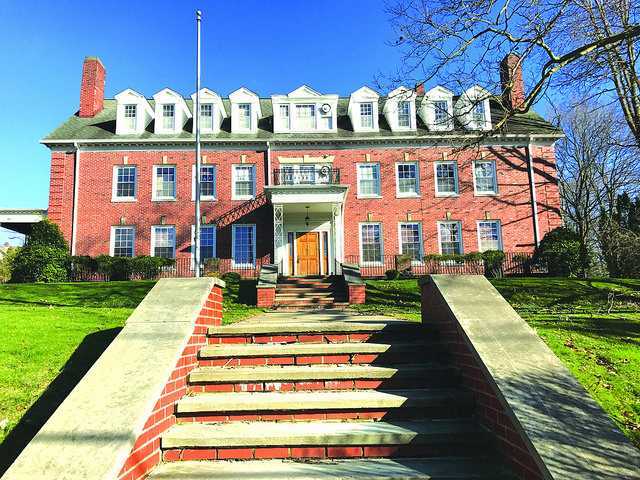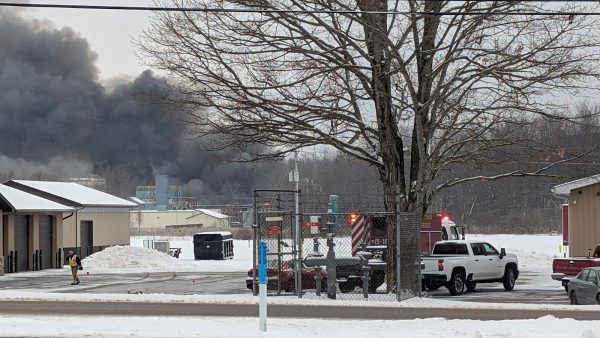Fraternity proposes return to campus
For the 2016–17 academic year, the former Sigma Alpha Epsilon fraternity house was leased by the college to house first-year female students. The college, according to Associate Director of Residence Life for Housing Gretchen Kerr, has no plans to continue to use the house for the 2017–18 academic year.
Members of the Sigma Alpha Epsilon fraternity’s national organization met with Allegheny College community members to discuss the possible recolonization of the fraternity to the college’s campus on Monday, March 6. The Pennsylvania Omega chapter of the fraternity has been suspended from Allegheny since July 2013.
The Campus reported on July 21, 2013, that Allegheny and the fraternity had agreed that the fraternity would be suspended from the college’s campus until the fall semester of the 2016–17 academic year.
This agreement came after two members of the fraternity — Jacob Bonessi and Gavin Gratson — were arrested and charged with the manufacture, delivery or possession of controlled substances with the intent to manufacture or deliver the substance and the possession of drug paraphernalia, among other charges.
Both Bonessi and Gratson pled guilty to four misdemeanors and were sentenced to probation and drug treatment programs including electronic monitoring in October 2013. Bonessi was also sentenced to a maximum of two days in confinement.
Deran Abernathy, who works with the fraternity’s alumni engagement, and Steve Orkis, ’08, were present on behalf of the fraternity. Abernathy said SAE would bring “additional resources” to the college. While the number of new members of fraternities at Allegheny has gone down in recent years, Abernathy said the fraternity would be willing to bring in advisers to assist in the Greek life recruiting process.
Community members in attendance asked how the fraternity would work to improve its reputation after recent occurrences at chapters nationwide. Bloomberg reported on March 7, 2014, that at least 10 deaths occurred between 2006 and 2014 in connection with hazing, drugs or alcohol at SAE events.
“There were a number of students who were literally dying to get into our organization,” Abernathy said.
Abernathy said the fraternity may have deserved its reputation as “America’s deadliest fraternity” and said this was a result of chapters operating below the national organization’s standards and its motto of “being true gentlemen.”
In 2013, Abernathy said the fraternity had a conversation with its insurance company, Lloyd’s of London, in which the company threatened to terminate the fraternity’s policy as a result of these deaths and other events. That, along with the events themselves, led to “organizational change.”
“When you start having a conversation with a company that will insure anything and everything and they’re talking about no longer insuring you, you have to create organizational change,” Abernathy said.
One such change in this process was the removal of the “pledging” process. Students who receive an offer to join SAE will become members of the fraternity 96 hours after receiving the “bid,” according to Abernathy. This ban went into effect March 9, 2014.
“This change will adopt a method, practice and policy that treat all members equally and fairly and strive for a continuous development of our members throughout their lives,” reads an undated press release on the fraternity’s website. “The education of our members will shift from a new-member (pledge) term to a holistic educational period in which members learn about the Fraternity’s values, mission, creed and history and develop personally over the course of their collegiate tenure.”
In addition to removing the pledging process, Abernathy said the fraternity has ensured its members’ GPAs would increase. He said the fraternity’s average GPA was 2.87 in 2011, increasing to 2.9 in 2013 and is now at least at 3.0.
“It was a very rough stretch to have that label [“America’s deadliest fraternity”] — rightfully and justifiably so — put on our organization, but out of adversity you can create great change,” Abernathy said. “And I think that we’re still in the midst of that happening, but we’re seeing a lot of really good success.”
When asked how the fraternity planned on enforcing new policies, Abernathy pointed to chapter closures around 2014. He said the fraternity voluntarily closed between 20 and 25 percent of its chapters nationwide. This, he said, was an opportunity to “reset.”
If the fraternity were allowed to recolonize at Allegheny, Abernathy said the chapter would have an adviser structure in place and would be expected to hold itself accountable. While Orkis said there was no current structure planned, he said the Pennsylvania Omega chapter has a strong alumni base.
In addition, Abernathy said the fraternity would make its house a “dry” house — that is, a house where alcohol is not allowed — and request a resident adviser in the house. He said the RA could be a member of the fraternity or not, but said there were some benefits to having the RA be a member, such as being able to attend initiation meetings to ensure the national organization’s policies were upheld.
Another community member asked about how the fraternity will address instances of perceived racism among its members.
In 2015, members of the fraternity at the University of Oklahoma were filmed performing a chant that used racial slurs, referenced lynching and said a black man would not be able to join the fraternity in the future.
Abernathy said he handled the investigation into that incident and found that the chant had been taught to that chapter by another chapter at a leadership convention. He said the University of Oklahoma chapter was closed following the incident and the portrayal of the fraternity as racist “isn’t really accurate.”
After that incident, according to Abernathy, SAE’s national organization hired a director of diversity and inclusion and adopted a nondiscrimination policy in summer 2015. In addition, he said the fraternity created base-level training regarding diversity and inclusion.
Orkis addressed concerns that members of the fraternity would repeat the behavior that led to the Pennsylvania Omega chapter’s suspension. He said the suspension allowed the national organization a chance for self-reflection.
Abernathy said the national organization’s self-reflection extended past Allegheny.
“We were on the verge of really having some systemic issues,” Abernathy said.
Abernathy said he “firmly believes” that 95 percent of the fraternity’s members live up to SAE’s organizational goals and that promoting self-policing would help alleviate behavioral issues. Orkis said the national organization would be “driving home accountability” if it were allowed to return to campus.
Regardless of these guarantees, some community members voiced concerns.
“I can’t say I’m looking forward to having the Department of Homeland Security blocking the alley again,” said Associate Professor of History and International Studies Department Chair Elisabeth Kalé Haywood, who said she is a neighbor of the fraternity’s house.
Robinson Whitaker, ’17, said the national organization’s reputation for being “America’s deadliest fraternity” is different than the perspectives of the affected chapters.
“When an occurrence occurs on a campus — to the national organization, it’s a risk. It is a liability that they must get rid of. And you’ve done that with 25 percent of your chapters,” Whitaker said. “But, for the campus, it’s real. It shakes it to its core. Someone dies. That’s scary. … One of my friends would be that person, possibly.”
Abernathy said the national organization has implemented an amnesty program for members who need medical attention and those who get assistance for those members. He said this did not forbid the national organization from taking action against the chapter as a whole, but the students themselves have amnesty.
To return to campus, SAE must be approved by the Board of Trustees, who will have their next meeting in May.
“We’re committed to bring the fraternity back in a positive way, but we’re also here to demonstrate that this is a long process,” Abernathy said. “Whether it happens in May, or it’s next May, … we’re committed and we’re here. And we’ll continue to be here and be committed.”








